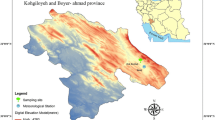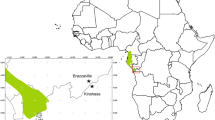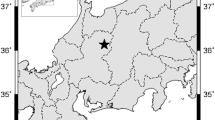Abstract
Key message
Earlywood width in Quercus crispula increased from 1970 to 2004 without changes of vessel anatomy and ring growth.
Abstract
The increase in diameter of a tree stem is an important indicator of forest productivity. Xylem traits, such as the number and cross-sectional area of earlywood vessels, are also critical parameters of forest growth because of the physiological and structural contribution of xylem to the growth of the tree stem. Forest productivity appears to be affected by climate change and, indeed, trees might be expected to acclimate to gradual long-term climate change. The aim of this study was to identify long-term changes in increases in stem diameter and in earlywood vessels by examining tree rings of Quercus crispula. Focusing on 20 mature specimens of Q. crispula, we examined annual ring growth from 1970 to 2004 and measured earlywood traits, namely, the width, cross-sectional area (henceforth referred to as area) and number of earlywood vessels, by digital image analysis. We developed a hierarchical Bayesian model for detection of long-term trends in these traits. We found that earlywood width, as well as the total number and area of earlywood vessels, increased during the 35 years under analysis. One possible cause of these changes might be the long-term elevation of temperatures in early spring, which determine the timing of the onset of cambial reactivation from winter dormancy. In contrast to the long-term changes, short-term, yearly changes in earlywood traits fluctuated to a smaller extent than yearly changes in tree ring width. Therefore, the observed long-term changes in earlywood appear to represent acclimation to long-term climate change.



Similar content being viewed by others
References
Abrams MD (2011) Adaptations of forest ecosystems to air pollution and climate change. Tree Physiol 31:258–261
Andreu-Hayles L, Planells O, Gutierrez E, Muntan E, Helle G, Anchukaitis KJ, Schleser GH (2011) Long tree-ring chronologies reveal 20th century increases in water-use efficiency but no enhancement of tree growth at five Iberian pine forests. Glob Change Biol 17:2095–2112
Anfodillo T, Carraro V, Carrer M, Fior C, Rossi S (2006) Convergent tapering of xylem conduits in different woody species. New Phytol 169:279–290
Anfodillo T, Deslauriers A, Menardi R, Tedoldi L, Petit G, Rossi S (2012) Widening of xylem conduits in a conifer tree depends on the longer time of cell expansion downwards along the stem. J Exp Bot 63:837–845
Arend M, Kuster T, Günthardt-Goerg MS, Dobbertin M (2011) Provenance-specific growth responses to drought and air warming in three European oak species (Quercus robur, Q. petraea and Q. pubescens). Tree Physiol 31:287–297
Asshoff R, Zotz G, Körner C (2006) Growth and phenology of mature temperate forest trees in elevated CO2. Glob Change Biol 12:848–861
Begum S, Nakaba S, Oribe Y, Kubo T, Funada R (2007) Induction of cambial reactivation by localized heating in a deciduous hardwood hybrid poplar (Populus sieboldii × P. grandidentata). Ann Bot 100:439–447
Begum S, Nakaba S, Bayramzadeh V, Oribe Y, Kubo T, Funada R (2008) Temperature responses of cambial reactivation and xylem differentiation in hybrid poplar (Populus sieboldii × P-grandidentata) under natural conditions. Tree Physiol 28:1813–1819
Begum S, Nakaba S, Yamagishi Y, Oribe Y, Funada R (2013) Regulation of cambial activity in relation to environmental conditions: understanding the role of temperature in wood formation of trees. Physiol Plant 147:46–54
Bowman DMJS, Brienen RJW, Gloor E, Phillips OL, Prior LD (2013) Detecting trends in tree growth: not so simple. Trends Plant Sci 18:11–17
Corcuera L, Camarero JJ, Gil-Pelegrin E (2004) Effects of a severe drought on Quercus ilex radial growth and xylem anatomy. Trees 18:83–92
Eilmann B, Zweifel R, Buchmann N, Fonti P, Rigling A (2009) Drought-induced adaptation of the xylem in Scots pine and pubescent oak. Tree Physiol 29:1011–1020
Fonti P, Garcia-Gonzalez I (2004) Suitability of chestnut earlywood vessel chronologies for ecological studies. New Phytol 163:77–86
Fonti P, Garcia-Gonzalez I (2008) Earlywood vessel size of oak as a potential proxy for spring precipitation in mesic sites. J Biogeogr 35:2249–2257
Fonti P, Eilmann B, Garcia-Gonzalez I, von Arx G (2009) Expeditious building of ring-porous earlywood vessel chronologies without losing signal information. Trees 23:665–671
Fonti P, von Arx G, Garcia-Gonzalez I, Eilmann B, Sass-Klaassen U, Gartner H, Eckstein D (2010) Studying global change through investigation of the plastic responses of xylem anatomy in tree rings. New Phytol 185:42–53
Garcia-Gonzalez I, Fonti P (2006) Selecting earlywood vessels to maximize their environmental signal. Tree Physiol 26:1289–1296
Gea-Izquierdo G, Fonti P, Cherubini P, Martin-Benito D, Chaar H, Canellas I (2012) Xylem hydraulic adjustment and growth response of Quercus canariensis Willd. to climatic variability. Tree Physiol 32:401–413
Gelman A, Carlin JB, Stern HS, Rubin DB (2003) Bayesian Data Analysis, 2nd edn. Chapman and Hall/CRC, London
Granier A, Anfodillo T, Sabatti M, Cochard H, Dreyer E, Tomasi M, Valentini R, Bréda N (1994) Axial and radial water flow in the trunks of oak trees: a quantitative and qualitative analysis. Tree Physiol 14:1383–1396
Handa IT, Körner C, Hattenschwiler S (2006) Conifer stem growth at the altitudinal treeline in response to four years of CO2 enrichment. Glob Change Biol 12:2417–2430
Hiura T (2001) Stochasticity of species assemblage of canopy trees and understory plants in a temperate secondary forest created by major disturbances. Ecol Res 16:887–893
Holmes RL (1983) Computer-assisted quality control in tree-ring dating and measurement. Tree Ring Bull 43:69–78
Holmes RL (1994) Dendrochronology Program Library Version 1994. Laboratory of Tree-Ring Research, University of Arizona, Tucson, AZ
Ishida A, Nakano T, Yazaki K, Matsuki S, Koike N, Lauenstein DL, Shimizu M, Yamashita N (2008) Coordination between leaf and stem traits related to leaf carbon gain and hydraulics across 32 drought-tolerant angiosperms. Oecologia 156:193–202
Kagawa A, Sugimoto A, Maximov T (2006) 13CO2 pulse-labelling of photoassimilates reveals carbon allocation within and between tree rings. Plant Cell Environ 29:1571–1584
Körner C, Asshoff R, Bignucolo O, Hattenschwiler S, Keel SG, Pelaez-Riedl S, Pepin S, Siegwolf RTW, Zotz G (2005) Carbon flux and growth in mature deciduous forest trees exposed to elevated CO2. Science 309:1360–1362
Levanic T, Cater M, McDowell NG (2011) Associations between growth, wood anatomy, carbon isotope discrimination and mortality in a Quercus robur forest. Tree Physiol 31:298–308
Martínez-Vilalta J, Cochard H, Mencuccini M, Sterck F, Herrero A, Korhonen JFJ, Llorens P, Nikinmaa E, Nolè A, Poyatos R, Ripullone F, Sass-Klaassen U, Zweifel R (2009) Hydraulic adjustment of Scots pine across Europe. New Phytol 184:353–364
McMahon SM, Parker GG, Miller DR (2010) Evidence for a recent increase in forest growth. Proc Natl Acad Sci USA 107:3611–3615
Nabeshima E, Kubo T, Hiura T (2010) Variation in tree diameter growth in response to the weather conditions and tree size in deciduous broad-leaved trees. For Ecol Manag 259:1055–1066
Nock CA, Baker PJ, Wanek W, Leis A, Grabner M, Bunyavejchewin S, Hietz P (2011) Long-term increases in intrinsic water-use efficiency do not lead to increased stem growth in a tropical monsoon forest in western Thailand. Glob Change Biol 17:1049–1063
Nowak RS, Ellsworth DS, Smith SD (2004) Functional responses of plants to elevated atmospheric CO2—do photosynthetic and productivity data from FACE experiments support early predictions? New Phytol 162:253–280
Nugroho WD, Marsoem SN, Yasue K, Fujiwara T, Nakajima T, Hayakawa M, Nakaba S, Yamagishi Y, Jin HO, Kubo T, Funada R (2012) Radial variations in the anatomical characteristics and density of the wood of Acacia mangium of five different provenances in Indonesia. J Wood Sci 58:185–194
Ohtsuka T, Saigusa N, Koizumi H (2009) On linking multiyear biometric measurements of tree growth with eddy covariance-based net ecosystem production. Glob Change Biol 15:1015–1024
Olson ME, Anfodillo T, Rosell JA, Petit G, Crivellaro A, Isnard S, León-Gómez C, Alvarado-Cárdenas LO, Castorena M (2014) Universal hydraulics of the flowering plants: vessel diameter scales with stem length across angiosperm lineages, habits and climates. Ecol Lett 17:988–997. doi:10.1111/ele.12302
Oribe Y, Funada R, Shibagaki M, Kubo T (2001) Cambial reactivation in locally heated stems of the evergreen conifer Abies sachalinensis (Schmidt) Masters. Planta 212:684–691
Oribe Y, Funada R, Kubo T (2003) Relationships between cambial activity, cell differentiation and the localization of starch in storage tissues around the cambium in locally heated stems of Abies sachalinensis (Schmidt) Masters. Trees 17:185–192
Overdieck D, Ziche D, Bottcher-Jungclaus K (2007) Temperature responses of growth and wood anatomy in European beech saplings grown in different carbon dioxide concentrations. Tree Physiol 27:261–268
Poorter L, McDonald I, Alarcón A, Fichtler E, Licona JC, Peña-Claros M, Sterck F, Villegas Z, Sass-Klaassen U (2010) The importance of wood traits and hydraulic conductance for the performance and life history strategies of 42 rainforest tree species. New Phytol 185:481–492
Preston K, Cornwell WK, Denoyer JL (2006) Wood density and vessel traits as distinct correlates of ecological strategy in 51 California coast range angiosperms. New Phytol 170:807–818
Saurer M, Siegwolf RTW, Schweingruber FH (2004) Carbon isotope discrimination indicates improving water-use efficiency of trees in northern Eurasia over the last 100 years. Glob Chang Biol 10:2109–2120
Shibata H, Kirikae M, Tanaka Y, Sakuma T, Hatano R (1998) Proton budgets of forest ecosystems on volcanogenous regosols in Hokkaido, northern Japan. Water Air Soil Pollut 105:63–72
Spiegelhalter DJ, Thomas A, Best NG, Lunn D (2003) WinBUGS 1.4 Manual. Imperial College and MRC Biostatistics Unit, IPH, London
Sterck FJ, Zweifel R, Sass-Klaassen U, Chowdhury Q (2008) Persisting soil drought reduces leaf specific conductivity in Scots pine (Pinus sylvestris) and pubescent oak (Quercus pubescens). Tree Physiol 28:529–536
Thomas DS, Montagu KD, Conroy JP (2007) Temperature effects on wood anatomy, wood density, photosynthesis and biomass partitioning of Eucalyptus grandis seedlings. Tree Physiol 27:251–260
Tsuchiya R, Furukawa I (2009) Radial variation of vessel lumen diameter in relation to stem increment in 30 hardwood species. IAWA J 30:331–342
Tyree MT, Zimmerman MH (2002) Xylem structure and the ascent of sap. Springer series in wood science. Springer, Berlin
Ueda MU, Müller O, Nakamura M, Hiura T (2013) Soil warming decreases inorganic and dissolved organic nitrogen pools in a Japanese cool temperate forest floor where mild freeze-thaw cycle exists during winter. Soil Biol Biochem 61:105–108
Watanabe Y, Satomura T, Sasa K, Funada R, Koike T (2010) Differential anatomical responses to elevated CO2 in saplings of four hardwood species. Plant Cell Environ 33:1101–1111
Way DA, Oren R (2010) Differential responses to changes in growth temperature between trees from different functional groups and biomes: a review and synthesis of data. Tree Physiol 30:669–688
West GB, Brown JH, Enquist BJ (1999) A general model for the structure and allometry of plant vascular systems. Nature 400:664–667
Zanne AE, Westoby M, Falster DS, Ackerly DD, Loarie SR, Arnold SEJ, Coomes DA (2010) Angiosperm wood structure: global patterns in vessel anatomy and their relation to wood density and potential conductivity. Am J Bot 97:207–215
Zhao MS, Running SW (2010) Drought-induced reduction in global terrestrial net primary production from 2000 through 2009. Science 329:940–943
Author contribution statement
EN, as the first author, designed the study, carried out field work and wood measurements, and wrote large part of the text. TK supported data analysis including statistical calculation and discussion of the results, and wrote parts of the text. KY assisted and advised tree ring analysis and vessel measurement. TH assisted with making conception of the study and read and commented on drafts of the paper. RF as the supervisor guided anatomical measurements as well as read and corrected drafts of the paper.
Acknowledgments
The authors thank T. Fujiwara and T. Kohyama for their assistance, valuable comments and discussions. They also thank T. Ishii and the staff of TOEF for their help and for arrangements related to the field work. This work was supported, in part, by Grants-in-Aid for Scientific Research from the Ministry of Education, Science, Sports and Culture of Japan (nos. 22 40073, 24380090 and 2529207903).
Conflict of interest
The authors declare that they have no conflict of interest.
Author information
Authors and Affiliations
Corresponding author
Additional information
Communicated by G. Wieser.
Electronic supplementary material
Below is the link to the electronic supplementary material.
468_2015_1206_MOESM1_ESM.pdf
Supplementary Figure 1 Density distributions of the vessel lumen areas in annual rings of every 5 years from 1970 to 2004. The vertical line indicates the threshold value for the lumen area of earlywood vessels (25,880 μm2) in all annual rings over the entire period, while arrows indicate threshold values for each period (see text). Supplementary Figure 2 Radial growth chronologies for each tree. The number at the top of each panel represents the identification number of each tree. Vertical lines indicate the studied period, 1970 and 2004. Supplementary Figure 3 Panels show observed data and predicted long- and short-term changes (b 1 and in Eq. (1)) with individual variability (in Eq. (1)) in the number (A) and total area (B) of earlywood vessels, the earlywood width (C) and the ring width (D) for each tree. The number at the top of each panel represents the identification number of each tree. Blue circles show observed data. Gray lines and shaded areas represent the predicted values when all individuals are pooled (as in Fig. 2), and orange lines and yellow-shaded areas represent predicted values that include individual variability, with 95 % credible intervals. (PDF 3366 kb)
Rights and permissions
About this article
Cite this article
Nabeshima, E., Kubo, T., Yasue, K. et al. Changes in radial growth of earlywood in Quercus crispula between 1970 and 2004 reflect climate change. Trees 29, 1273–1281 (2015). https://doi.org/10.1007/s00468-015-1206-3
Received:
Revised:
Accepted:
Published:
Issue Date:
DOI: https://doi.org/10.1007/s00468-015-1206-3




